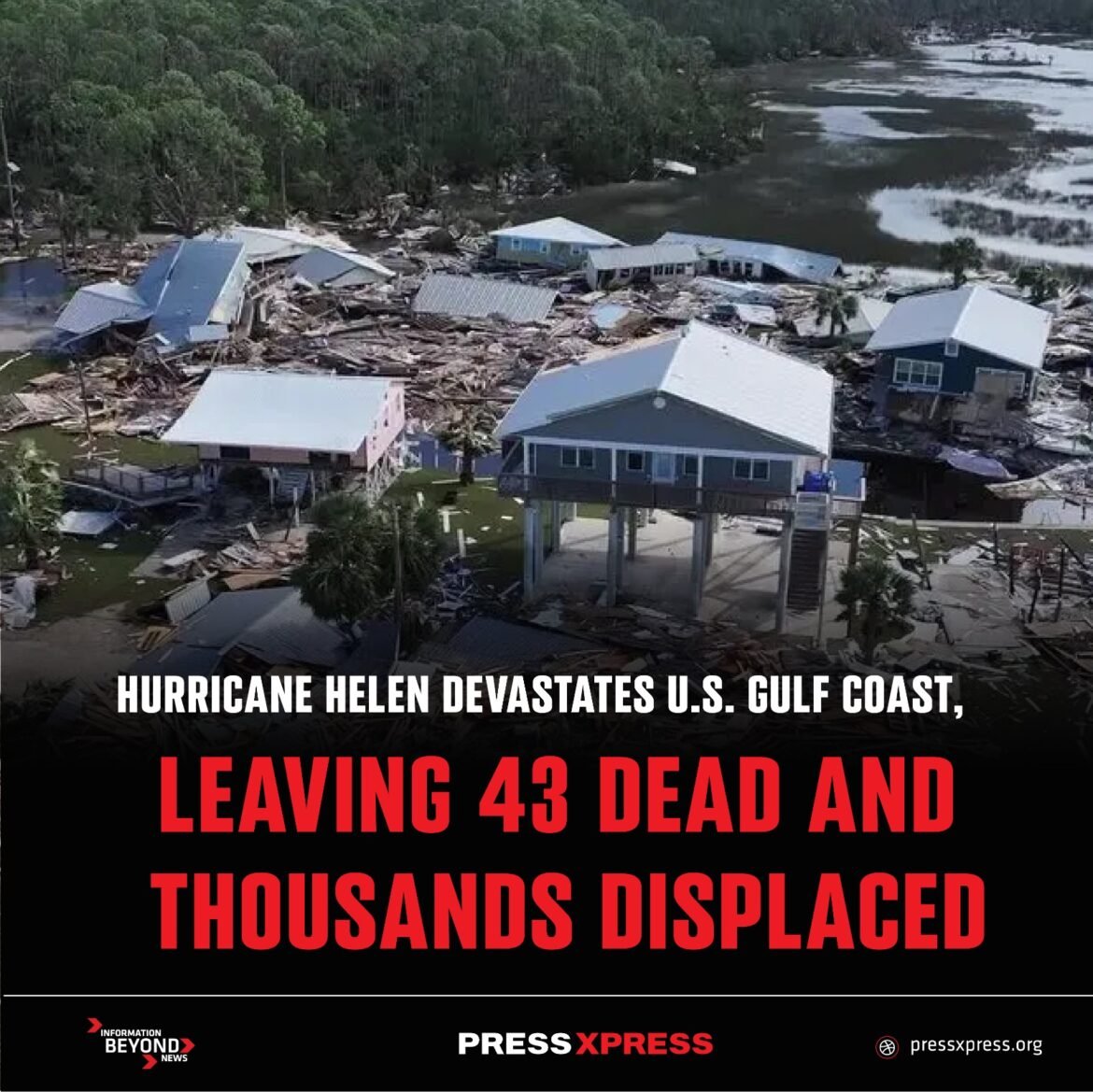Hurricane Helen has unleashed catastrophic destruction across the U.S. Gulf Coast, killing at least 43 people and displacing thousands more. The storm, one of the most powerful in recent years, made landfall on Saturday afternoon, bringing with it torrential rain, severe flooding, and hurricane-force winds. Striking Texas and Louisiana hardest, the hurricane forced widespread evacuations, leaving countless homes in ruins and hundreds of thousands without power. As federal and state emergency responses ramp up, the scale of the damage is still being assessed, with rescue operations ongoing and concerns about the storm’s future path.
Hurricane Helen made landfall with unprecedented force, slamming into Texas and Louisiana with wind speeds exceeding 120 mph and relentless rainfall causing widespread flooding. Coastal towns were among the hardest hit, with homes completely submerged and infrastructure, including roads and bridges, severely damaged or destroyed. Residents in the hurricane’s path were urged to evacuate, and thousands sought refuge in emergency shelters set up by local authorities and relief agencies. Those unable to leave their homes before the storm struck found themselves trapped by rising floodwaters, with rescue teams still working to reach stranded residents in remote and hard-to-access areas.
The power grid in the affected regions has been decimated, leaving over 100,000 people without electricity. Utility companies have dispatched crews, but officials warn that it could take days or even weeks to fully restore power, especially in areas where flooding has made roads impassable. The immediate concern remains rescuing survivors and providing them with basic necessities, such as clean water, food, and medical care, as the scale of the devastation continues to unfold.
A Race Against Time
Ahead of the hurricane’s landfall, both Texas and Louisiana declared states of emergency, enabling local and federal agencies to mobilize critical resources. The Federal Emergency Management Agency (FEMA) has deployed teams to the hardest-hit areas, working in coordination with state authorities to facilitate ongoing rescue efforts and distribute essential supplies. Federal response teams have been bolstered by local volunteers, law enforcement, and the National Guard, all of whom are conducting search-and-rescue missions in flood-affected areas.
While rescue operations are in full swing, logistical challenges remain, especially in reaching isolated communities. Floodwaters have cut off several areas, making airlifts and boat rescues the primary means of evacuating stranded residents. Emergency medical teams have also been dispatched to treat those injured or in need of medical attention, with makeshift clinics established in emergency shelters. Despite the swift response, the enormity of the damage and the overwhelming need for assistance means that the road to recovery will be long and arduous
A Growing Threat Behind Intensifying Hurricanes
As Hurricane Helen’s aftermath unfolds, scientists and environmentalists are pointing to climate change as a significant factor in the storm’s intensity. Warmer ocean temperatures, driven by global warming, are fueling stronger and more frequent hurricanes. Helen, in particular, intensified rapidly before landfall, a phenomenon that climate scientists have been warning about for years. Rising sea levels also exacerbate flooding risks, with storm surges pushing water further inland and submerging coastal communities.
Experts caution that storms like Helen may become more common in the coming years, with climate change altering weather patterns and increasing the likelihood of more destructive hurricanes. This storm has renewed calls for enhanced climate action, both to mitigate future risks and to improve infrastructure resilience in vulnerable areas. Coastal communities, in particular, face growing challenges in fortifying their defenses against the rising threat of climate-fueled extreme weather events.
Assessing the Full Scope of the Damage
As rescue efforts continue, the true extent of Hurricane Helen’s destruction is slowly becoming clearer. Entire neighborhoods have been washed away, and critical infrastructure, including hospitals, schools, and transportation networks, has suffered extensive damage. In the hardest-hit areas, agricultural land has been flooded, with the potential for long-term economic impacts as farmers assess their losses. Local officials estimate that it will take days, if not weeks, to fully assess the damage, and even longer to begin meaningful recovery efforts.
The federal government has pledged full support in the aftermath of the storm, with the President offering condolences to the families of the victims and promising robust federal aid for recovery and rebuilding. In addition to financial assistance, the recovery process will involve the deployment of engineering and construction teams to rebuild damaged infrastructure and restore essential services. However, experts warn that the economic toll of Hurricane Helen could run into the billions, making it one of the most costly natural disasters in recent memory. Recovery will not only focus on rebuilding homes and businesses but also on strengthening coastal defenses to protect against future storms.
Future Risks and Precautions
Although Hurricane Helen has weakened, the National Weather Service has issued further warnings as the storm moves along the East Coast. While it is no longer classified as a hurricane, remnants of the storm could still bring heavy rainfall and flash flooding to vulnerable areas. Authorities are urging residents in its potential path to remain vigilant and to heed evacuation orders if necessary.
Helen’s impact has served as a sobering reminder of the power of nature and the growing risks posed by climate change. Communities along the Gulf Coast, in particular, will need to rethink disaster preparedness strategies, including reinforcing flood defenses and investing in resilient infrastructure. As the frequency and intensity of hurricanes continue to rise, experts warn that governments at all levels must take more proactive measures to protect their citizens and mitigate the long-term effects of climate change


